Communication
| Site: | Cowichan Valley School District - Moodle |
| Course: | ELA10 - Creative Writing (2 credit), CSS, Cizeron |
| Book: | Communication |
| Printed by: | Guest user |
| Date: | Friday, 19 December 2025, 8:53 AM |
Table of contents
- Introduction
- Summary Explanation of Assignments
- ASSIGNMENT 1: Stealing First Base
- Expository Writing
- ASSIGNMENT 2: Expository Writing
- Descriptive Writing
- ASSIGNMENT 3: Descriptive Writing
- ASSIGNMENT 4: Developing Characters
- ASSIGNMENT 5: Conflict
- ASSIGNMENT 6: Plot
- Narrative Writing
- ASSIGNMENT 7: Feedback Forum
- ASSIGNMENT 8: PROJECT - Producing a Short Story
- Written Short Story
- Graphic Novel
- Movie
Introduction
Effective communication requires that we...
- Connect and engage with others
- Acquire, interpret and present information
- Collaborate to plan, carry out, and review constructions and activities
- Explain/recount and reflect on experiences and accomplishments
Consider all of these elements as you work through the assignments in this section.
Summary Explanation of Assignments
Here is a quick overview of the assignments for this unit. However, be sure you read over the specific assignment instructions that follow for each one. Review the marking rubrics for the assignments before you start.
ASSIGNMENT 1: Stealing First Base - Citation
This assignment is not only designed to teach you to properly cite your sources, but it also gets you into a library so you can see that inspiration can be found anywhere.
ASSIGNMENT 2: Expository Writing
It is important to know how to communicate clearly and effectively. Expository writing should be concise and accurately state your main idea. Be sure to read over the information on how to write effective expository papers.
ASSIGNMENT 3: Descriptive Writing
You should know how to visually describe the significance of an observation to better represent the importance of a scene, memory, character, etc. There are many applications of descriptive writing and being aware of your surroundings.
ASSIGNMENT 4: Developing Characters
One of cornerstones of telling a good story is having fully developed characters.
ASSIGNMENT 5: Conflict
Conflict is a driving force in narrative writing.
ASSIGNMENT 6: Plot
Demonstrate your learning of storytelling by pulling together all of your brainstorming into a coherent and structured plot outline. Make sure you know what a good plot diagram looks like.
ASSIGNMENT 7: Feedback FORUM
Submit a sample of your writing to the forum. You could use this opportunity to share your short story and get feedback not only from your teacher, but from your peers. If you're not ready to submit your short story, you could select a piece of writing you would like to share. Use this opportunity to collaborate. You must respond to another student's post, as well. Suggest editing ideas, offer constructive advice for clarity, and identify an aspect you enjoyed.
ASSIGNMENT 8: PROJECT: Producing a Short Story
Develop your story into your own format.
ASSIGNMENT 1: Stealing First Base
|
Learning Target (Curricular Competencies):
|
Task:
Writers, even professional writers, are not adverse to "stealing" or using lines that come from other sources. Usually a writer acknowledges these sources when they read or publish their work. Interesting things happen when we "lift" words from a source other than our own brain or imagination. Surprising new vocabulary, insights, or ideas can happen in our work.
So -- head to the library or online. Choose six different books or songs or pieces of poetry and lift a word or phrase from each of those sources. It works well to choose a series of book titles or to find random lines that speak to you. Be creative in your selections. Demonstrate your ability to use other sources to inspire your own creativity and create original work.
Now, having stolen to first base, make that piece of work your own. Rearrange the words or lines, add your own words, create a piece that was inspired by others, but written by you. (with a little help from your friends...)
IMPORTANT
Be sure to acknowledge your sources in MLA format. Read the handout on MLA CITATION in Class Handouts at the top of the course.
There are also a number of online sites that will generate your citations for you!! Try citationmachine.
You will need 6 citations.
Assessment: Below you will find the exemplary criteria used to assess the assignment.
Learning Target: (Exemplary 6/6): Exemplary comprehension of the task and clear accomplishment of the objective. Student accesses information from diverse sources to transform ideas and information to create original text. Student accurately uses acknowledgements and citations to recognize intellectual property rights by citing sources using correct formatting.
Written Expression: (Exemplary (6/6): Sentence structure and vocabulary are varied, skillfully written, and carefully chosen. Work has been proofread and there are few or no errors in spelling, capitalization, punctuation, and grammar. Content contributes to the central idea and makes insightful connections with logical organization.
Submission:
Use the "2.1 Stealing First Base - Citation" link on the main page of this section of the course to upload your assignment to your teacher for marking.
Expository Writing
Definition |
Expository writing will inform, explain, clarify, define, or instruct. |
| Characteristics |
|
| Sample Topics |
|
| Additional Websites |
ASSIGNMENT 2: Expository Writing
|
Learning Target (Curricular Competencies):
|
Task:
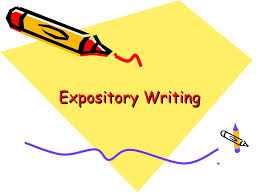 Expository writing is a type of writing where the purpose is to explain, inform, or even describe.
Expository writing is a type of writing where the purpose is to explain, inform, or even describe.
1. Make sure you review the characteristics and examples of expository writing in the introduction to this lesson before you begin this assignment. Here is another helpful site.
2. Create a set of instructions. The instructions could be based on a concrete situation such as "How to program your new DVR player" or be more abstract such as "How to live in this world and still be happy". Be aware of your audience.
- Try to develop a specific voice that is consistent throughout the writing. Writer's Digest offers some suggestions.
- Choose a title and an idea and write the piece using the conventions of an expository writing.
- You may use humour or hyperbole to twist the piece, if you'd like.
Assessment: Below you will find the exemplary criteria used to assess the assignment.
Learning Target: (Exemplary 6/6): Exemplary comprehension of the task and clear accomplishment of the objective. Student demonstrates exemplary understanding of the text features, structure, and format of expository writing. There is a clear purpose. Ideas are fully developed. Accomplishes the purpose with originality, individuality, and maturity and sophistication.
Written Expression: Exemplary (6/6): Sentence structure and vocabulary are varied, skillfully written, and carefully chosen. Work has been proofread and there are few or no errors in spelling, capitalization, punctuation, and grammar. Content contributes to the central idea and makes insightful connections with logical organization.
Submission:
Use the "2.2 Expository Writing" link on the main page of this section of the course to upload your assignment to your teacher for marking.
Descriptive Writing
| Definition |
Descriptive writing vividly portrays a person, place, or thing such a way that the reader can visualize the topic and enter into the writer's experience and mood. |
| Characteristics |
|
| Sample Topics |
|
| Additional Websites |
http://www.webenglishteacher.com/descriptive.html |
ASSIGNMENT 3: Descriptive Writing
|
Learning Target (Curricular Competencies):
|
Task:
The primary purpose of descriptive writing is to describe a person, place or thing in such a way that a picture is formed in the reader's mind. Capturing an event through descriptive writing involves paying close attention to the details by using all of your five senses. This is called imagery.
Descriptive writing also incorporates figurative language. This will include similes, metaphors, personification, to name just a few examples. Make sure you review these terms so you can demonstrate your understanding in your response.
Watch the video below to review descriptive writing.
Click here for a sample descriptive paragraph.
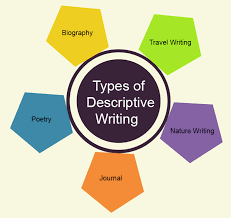
Choose one of these types of descriptive writing, JOURNAL, POETRY, NATURE WRITING, TRAVEL WRITING, BIOGRAPHY, and write a paragraph/scene that includes imagery and other figurative language. You may want to describe a travel experience you have had or wish to have. You might describe a scene from nature or a person. You might wish to write a descriptive poem or journal. Just make sure that your response demonstrates your ability to use imagery and figurative language.
Assessment: Below you will find the exemplary criteria used to assess the assignment.
Learning Target: (Exemplary 6/6): Exemplary comprehension of the task and clear accomplishment of the objective. Student demonstrates exemplary understanding of the text features, structure, and format of descriptive writing. Student demonstrates exemplary ability to incorporate imagery and figurative language to convey a clear purpose. Ideas are fully developed. Accomplishes the purpose with originality, individuality, and maturity and sophistication.
Written Expression: Exemplary (6/6): Sentence structure and vocabulary are varied, skillfully written, and carefully chosen. Work has been proofread and there are few or no errors in spelling, capitalization, punctuation, and grammar. Content contributes to the central idea and makes insightful connections with logical organization.
Submission:
Use the "2.3 Descriptive Writing" link on the main page of this section of the course to upload your assignment to your teacher for marking.
ASSIGNMENT 4: Developing Characters
|
Learning Target (Curricular Competencies):
|
Task:
Writing about characterization involves how characters are revealed through action, dialogue, and thoughts. A successful character analysis will discuss values and traits of a particular character, how the character undergoes change, and/or what he or she might represent. There are 2 ways to describe characters: directly or indirectly. Watch the video below on how to characterize.
1) Do you know the difference between indirect characterization and direct characterization?
2) Watch the video below on the different types of characters found in literature.
3) Do a 10 minute timed write that's a character sketch of a person you admire. Show, don't tell as you write about this character. Try using one of the graphic organizers in the folder at the top of the course. Brainstorm characteristics of this person. How might this character show a generous personality, for example? Watch the wikihow on writing character sketches to better understand.
4) "Show, don't just tell" the character. Reveal who he/she is by his/her actions.
5) Submit your character sketch in whatever format you used to develop it. There are templates in the Graphic Organizers folder on the top of the course, if you want.
Assessment: Below you will find the exemplary criteria used to assess the assignment.
Learning Target: (Exemplary 6/6): Exemplary comprehension of the task and clear accomplishment of the objective. Student demonstrates critical, creative, and reflective thinking to explore how language constructs personal and cultural identities recognizing how different features and forms of texts enhance and shape meaning and impact. Student demonstrates superior and insightful understanding of character development with both direct and indirect characterization.
Written Expression: Exemplary (6/6): Sentence structure and vocabulary are varied, skillfully written, and carefully chosen. Work has been proofread and there are few or no errors in spelling, capitalization, punctuation, and grammar. Content contributes to the central idea and makes insightful connections with logical organization.
Submission:
Use the "2.4 Developing Characters" link on the main page of this section of the course to upload your assignment to your teacher for marking.
ASSIGNMENT 5: Conflict
|
Learning Target (Curricular Competencies):
|
Task:
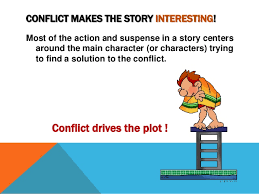
1. There are 2 main types of conflict found in literature: internal and external. Watch the video on conflict to review the 3 types of external conflict and the one type of internal conflict.
2. Then demonstrate your understanding by engaging the character you developed in the previous lesson in a conflict. Write a short piece where your character undergoes conflict. You must identify the type of conflict your character is facing.
Consider the problem to be solved. How does your character respond to it? What might this character do? You can choose to write your character into all the conflicts with short examples, or you can can develop one main conflict in a longer piece. Just be sure to clearly identify which conflict (s) you have chosen. If you use dialogue, be sure to format it correctly. Here is some help in generating, punctuating, formatting dialogue. You will need to develop your conflict thoroughly so your resolution is logical.
Assessment: Below you will find the exemplary criteria used to assess the assignment.
Learning Target: (Exemplary 6/6): Exemplary comprehension of the task and clear accomplishment of the objective. Student demonstrates superior and insightful understanding of conflict. There is clear identification of the type of conflict with a thoroughly developed and logical resolution. Student demonstrates critical, creative, and reflective thinking to explore how language constructs personal and cultural identities recognizing how different features and forms of texts enhance and shape meaning and impact.
Written Expression: Exemplary (6/6): Sentence structure and vocabulary are varied, skillfully written, and carefully chosen. Work has been proofread and there are few or no errors in spelling, capitalization, punctuation, and grammar. Content contributes to the central idea and makes insightful connections with logical organization.
Submission:
Use the "2.5 Conflict" link on the main page of this section of the course to upload your assignment to your teacher for marking.
ASSIGNMENT 6: Plot
|
Learning Target (Curricular Competencies):
|
Task:
1. One of the cornerstones of narrative writing, telling a story, is the plot. Watch the video below to review the 5 parts of plot.
Plot is the structure of a story; the sequence of events or actions that take place in the story.
| Intro (exposition) | should spark interest, provide background formation and establish the setting |
| Motivating Incident | the event which begins the story's action |
| Rising Action | a series of obstacles or problems that lead to the climax |
| Climax | the high point of tension or suspense in a story. Usually involves a resolution of conflicts |
| Falling Action | deals with the effects that the climax has on the characters |
| Conclusion (denouement) | briefly explains any details that require further clarification |
2. You are going to develop a plot outline, but you have 2 choices. You will need to include at least 12 events (minimum one for each part of the plot: introduction, rising action, climax, falling action, conclusion) on your plot outline, whichever option you choose.
a. Create a plot diagram for your own creative story or narrative.
OR
b. Examine and diagram the plot of a movie, music video, or documentary . Be sure to identify the title of your selection.
Assessment: Below you will find the exemplary criteria used to assess the assignment.
Learning Target: (Exemplary 6/6): Exemplary comprehension of the task and clear accomplishment of the objective. Student demonstrates critical, creative, and reflective thinking to explore how plot structure enhances and shapes meaning and impact. Student demonstrates exemplary active reading skills to comprehend and respond to text and identify elements of plot structure. All activities are complete.
Written Expression: Exemplary (6/6): Sentence structure and vocabulary are varied, skillfully written, and carefully chosen. Work has been proofread and there are few or no errors in spelling, capitalization, punctuation, and grammar. Content contributes to the central idea and makes insightful connections with logical organization.
Submission:
Use the "2.6 Plot" link on the main page of this section of the course to upload your assignment to your teacher for marking.
Narrative Writing

| Definition |
Narrative writing tells a story or part of a story. |
| Characteristics |
|
| Sample Topics |
|
| Additional Websites |
ASSIGNMENT 7: Feedback Forum
|
Learning Target (Curricular Competencies):
|
Task:
Submit a sample of your writing to the forum. You could use this opportunity to share your short story and get feedback not only from your teacher, but from your peers.
If you're not ready to submit your short story, you could select a piece of writing you would like to share.
There are TWO activities in a FORUM:
- Go to the main page of the course and click on 2.7 Feedback Forum. Start a new discussion topic by clicking on Add a New Discussion Topic.
- Reply/Respond to someone else's discussion topic by clicking on their topic and selecting Reply. Suggest editing ideas, offer constructive advice for clarity, and identify an aspect you enjoyed. Try using the following prompts to guide your response to another post. "I wonder…" "I know…" "I can…" Don't just agree or disagree.
Assessment: Below you will find the exemplary criteria used to assess the assignment.
Learning Target: (Exemplary 6/6): Exemplary comprehension of the task and clear accomplishment of the objective. Student demonstrates exemplary ability to use writing and design processes to plan, develop, and create engaging and meaningful texts for a variety of purposes and audiences. Accomplishes the purpose with originality, individuality, and maturity and sophistication.
Response/Reply: Exemplary (6/6): The response/reply is thoughtful, insightful and respectfully exchanges ideas and viewpoints. Student demonstrates an exceptional level of understanding and communication of shared information.
Submission:
Use the "2.7 Feedback Forum" link on the main page of this section of the course to post your forum response to your teacher for marking.
ASSIGNMENT 8: PROJECT - Producing a Short Story
|
Learning Target (Curricular Competencies):
|
Task:
You've done all the preparation for this project. Let's put it all together by producing a short story. However, you can present your story in written format or visual format.
There are 3 choices here:
- Written Short Story
- Graphic Novel
- Movie
There is an explanation for each of these options. Just choose ONE! Make sure you read over the guidelines for each of the options and review the exemplary criteria so you know what is expected for this project. Be sure to include your planning.
Assessment: Below you will find the exemplary criteria used to assess the assignment.
Learning Target: (Exemplary 6/6): Exemplary comprehension of the task and clear accomplishment of the objective. Student demonstrates superior story writing skills. Plot is efficiently developed around a relatively mature conflict with a clear climax. There is an identifiable and logical resolution to the story. There is appropriate pacing and a strong narrative voice with a consistent point of view. There is a clear setting and consistent and developed characterization. Story elements demonstrate complex, engaging ideas, language, and techniques.
Evidence of Planning: Exemplary use of writing and design processes to plan, develop, and create engaging and meaningful texts for a variety of purposes and audiences. There is clear evidence of planning in the form of rough notes, outline, story map, or storyboard.
Overall Presentation: Product uses features of the genre and format in a mature, efficient manner to aid in the overall purpose of enhancing meaning and artistry. Presentation is original and unique. Student demonstrates exemplary understanding of text features, structure, and format to communicate purpose. The story format creates an impact, with a sense of vitality, economy, and finesse.
Written Expression: Exemplary (6/6): Sentence structure and vocabulary are varied, skillfully written, and carefully chosen. Work has been proofread and there are few or no errors in spelling, capitalization, punctuation, and grammar.
Submission:
Use the "2.8: PROJECT: Producing a Short Story" link on the main page of this section of the course to upload your assignment to your teacher for marking.
Written Short Story
Here are some guidelines for your short story:
- Your story should have ONE main character and a MAXIMUM of THREE supporting characters.
- Your story must have a clear plot.
- Your story could include effective dialogue.
- Your story should include some type of conflict.
- Length? It's a short story...so 3 - 5 pages.
Organize
Your short story still needs to have all the major aspects of a narrative! Not sure what these are...
- Plot Structure
- Setting
- Character Development
- Conflict
- etc...
Create an outline of your story. You don't necessarily have to write out the whole story, only the main points. However, it is at this point that it is essential that you remember the main structure of the short story! Make sure you develop your characters and your plot!!!
Story Map
Now that you have your outline, you need to create a Story Map. A story map is a visual depiction of the settings or the sequence of major events and actions of story characters.
The most important part of this part of your assignment is your planning and a Story Map is a way to plan and organize your short story. You can complete your Story Map in ONE of two ways:
EITHER: Online Interactive Story Map
- Go to Story Mapping. [ReadWriteThink.org] Note:This link is to an insecure server which means that your browser will probably provide a warning and ask you to approve accessing this material.
- Follow the instructions and complete your Story Map.
- Click here to download the Story Map pages.
- Print the pages.
- Complete the pages.
Create
Now that you have planned and organized your story, it is time to write it. You will need to write a draft (or two) and have some mature writers read, review and edit it for you.
You may also upload it to your teacher for review BEFORE you do your final copy. Make sure you let your teacher know that it is a draft - put DRAFT at the top of the page and/or use Notes (in the upload link) to indicate that it is a draft.
Final Review
Once you have completed your Short Story you need to look it over once more and make any changes.
Some questions to ask yourself:
- Can the reader clearly identify my characters? Can they clearly see the characterizations?
- Does my plot develop? Introduction, Motivating Incident...Rising Action...Climax...Resolution?
- Is the setting clearly defined?
- Does the dialogue make sense?
- Is the story original and unique?
- Does the first line of the story hook you?
- Do the characters have unique characters rather than being stereotypical?
- Are the events in the story real and believable?
- Is the Point of View consistent throughout the story?
Make any changes you need to and, once you are happy with your story, you are ready to upload it to your teacher. Don't forget to submit evidence of your planning.
Graphic Novel
Organize
Your graphic novel still needs to have all the major elements of a narrative! Not sure what these are...
- Plot Structure
- Setting
- Character Development
- Conflict
- etc...
Create an outline of your entire story. You don't necessarily have to write out the whole story, only the main points. However, it is at this point that it is essential that you remember the main structure of the short story! Make sure you develop your characters and your plot!!! A graphic novel is not just a picture book! It uses images and words to develop a story; you must do the same.
Storyboard
Now that you have your outline, you need to story board. Story boarding is used by film makers to get an idea of the shots they need, to tell their story. We are going to use storyboarding so that you know what stills you need to tell your story.
For your stills you can draw them if you are so gifted, or you can take pictures. Get your actors together, have a plan of the shots you want, set your actors up, and shoot your stills. You can then upload them to your computer and use any presentation or design software to arrange them in graphic novel formats and add your dialogue.
The most important part of this part of your assignment is your planning. You can download a storyboarding sheet and use it to get a plan for your story. You don't need to spend lots of time drawing your plan out, simple stick man will do. Just make sure you have a clear vision for what that block will look like to accomplish its purpose.
- Storyboard Example
-
Storyboard Templates 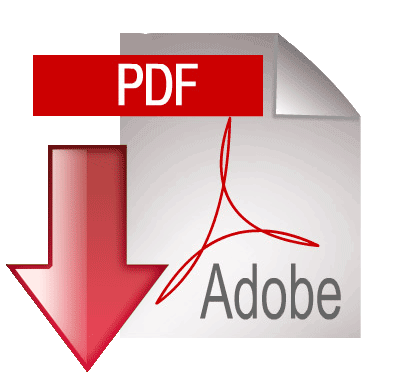
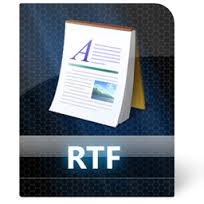
Create
So now that you have a rough idea of the images you will need, you need to create them.
Options for Creating Images
- Take Digital Photos. Set up your story, and take pictures. It will be similar to acting out the story, except you don't have to memorize lines. Get some friends and give them characters. Set up your scenes and take as many photos as possible. That way you have lots of options. Use your digital pictures for your comic.
- Use online software and adopt characters from their database.
- Draw your images. If you are a gifted artist, this will be your best bet.
- OTHER IDEAS?? You may have even better ideas than this to create your images like using Lego! Feel free to message me with some ideas if you need some help
Put it All Together
Now that have all your stills, you just have to put the book together. If you have drawn your book then you're done. Simply scan it and submit it.
If you are still creating it online, you need to upload your images, decide what software you're going to use, and add your dialogue.
Some ideas for creating your graphic novel:
- Photostory - a product for Windows that enables you to create a visual story using graphics/photos, text, audio and video
- Photoshop OR Gimp - create your own comic strip pages, with plot and dialogue bubbles. Save each page and create a slideshow. Save as .swf file.
- Microsoft Power Point OR Open Office Impress - create images and put them on slides.
- Webpage - design a webpage that has links that flow through your story. You will need to send me the link then for the assignment.
- Comic Life - if you have access to this program, you can use it to create the novel. (you will need to export the file as a .jpeg)
- Scan it - if you have chosen to draw your novel, all you need to do is scan it (and save it as .pdf or .jpeg). Be sure to put it together into ONE file, rather than uploading multiple files.
If you have any other ideas of what you would like to do, feel free to message me and discuss options.
Final Review
Once you have completed your Short Story you need to look it over once more and make any changes.
Some questions to ask yourself: Do I have...?
- At least 30 scenes - you may have multiple scenes on one page and are encouraged to have more scenes than 30
- Use of Dialogue - does your dialogue aid your story's development
- Plot development - contains solid plot structure, identifiable conflict and resolution
- Character development - consistent, and developed
- Setting
- Graphics - help develop setting and character, aid the story's development, engaging
- Title
- Evidence of Planning
Movie
Here are some guidelines for your movie:
- Your movie should have ONE main character and a MAXIMUM of THREE other characters.
- Your movie must have a clear plot.
- Your movie could include dialogue, music, sound effects.
- Your movie should include some type of conflict or issue or problem to overcome.
- Length? It's a short film...MAXIMUM 3 minutes.
Organize
Your movie needs to have all the major aspects of a narrative! Not sure what these are...
- Plot Structure
- Setting
- Character Development
- Conflict
- etc...
Create an outline of your movie. You don't necessarily have to write out the whole story of the movie, only the main points. However, it is at this point that it is essential that you remember the main structure of the short story! Make sure you develop your characters and your plot!!! A movie is not just moving pictures! It uses images and sound to tell a story; you must do the same.
The video to the right explains how to make an animated film BUT the planning aspects of it relate to all movies.
Storyboard
Now that you have your outline, you need to story board. Story boarding is used by film makers to get an idea of the shots they need, to tell their story.
All About Storyboards
A storyboard is a powerful document that contains all the visual, audio and time components of your video. You can use pictures to describe the visual element, like this:
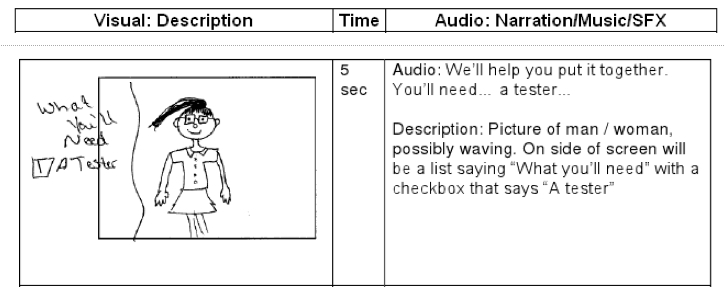
Storyboards capture these three elements for every scene of your video:
Visual/Description—A quick, rough sketch—no need to be an artist!
Time—The length of this particular image, in seconds.
Audio—Narration/Music/SFX - What you will be hearing when the image is shown. The three major components of audio are: Narration (people speaking), Music (background sound) or Sound Effect (SFX)—doors opening, car horns, birds calling, etc.
Storyboards can also skip the pictures and just describe the visual elements:

Do not use a script, since it lacks the visual descriptors and only captures the dialogue.
Storyboard Templates
The most important part of this part of your assignment is your planning. You can download a storyboarding sheet and use it to get a plan for your story. You don't need to spend lots of time drawing your plan out, simple stick men will do. Just make sure you have a clear vision for what that block will look like to accomplish its purpose.
- Storyboard Example
-
Storyboard Templates 

Create
Now you are ready to create your film. There are many different ways to create your film:
- using real-life actors
- using Lego or other "toy" figures (using the "Stopmotion" technique)
- using online cartoon character,
- and so on.
Software
- Windows Moviemaker
- iMovie (Mac)
- Go Animate - an online program that creates moving cartoons
- Movie Storm - an online program that you can use to create moving cartoons
- Xtranormal - an online program that you can use to create moving cartoons
Final Review
Once your Movie is done, you need to look it over. It should be engaging, but it should still have a good story line.
Some questions to ask yourself:
- Can the reader clearly identify my characters?
- Does my plot develop?
- Clearly defined setting?
- Audio makes sense and adds to the story?
- Scenes look professional, and clear?
Once you're happy with your product, you're ready to submit it.
Assessment
- 2 - 3 minutes long
- Use of Dialogue/Audio - does your dialogue/music enhance your story?
- Plot development - contains solid plot structure, identifiable conflict and resolution
- Character development - consistent, and developed
- Setting
- Evidence of planning
- Overall Presentation